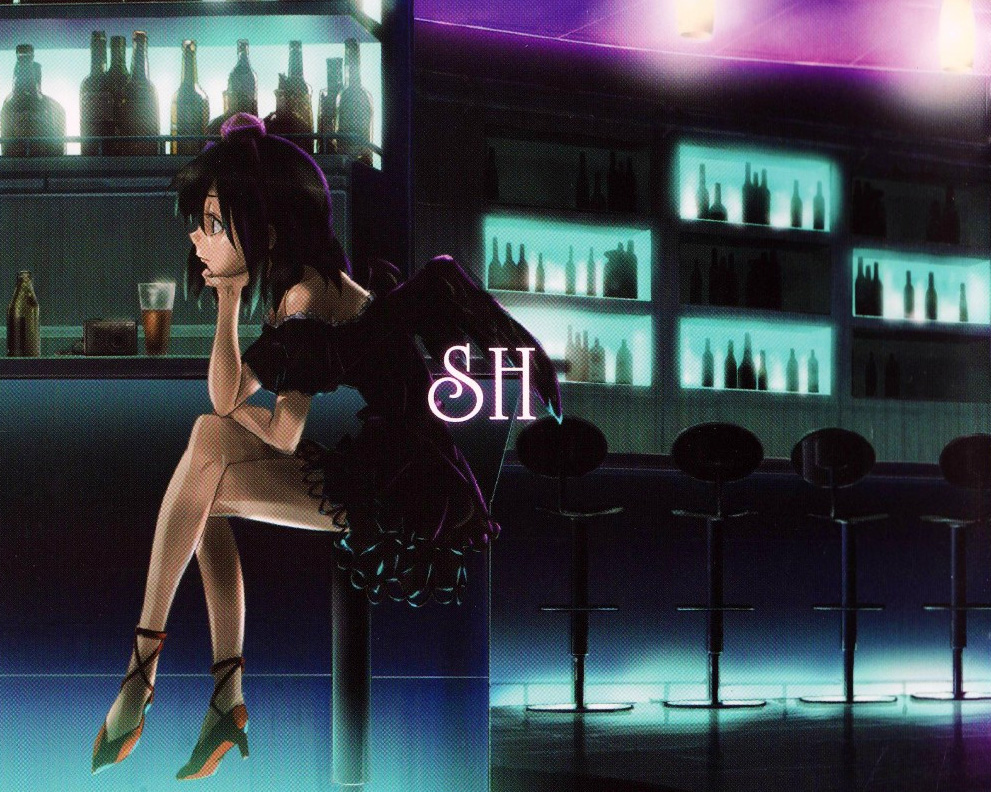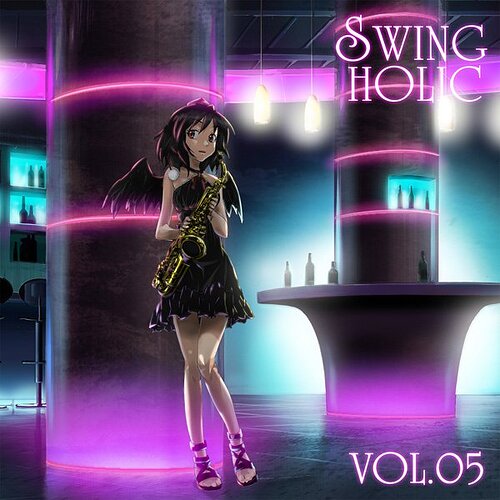First of all… Sorry for not posting any reviews for January at all. Between work, other projects, and efforts acquiring and listening to new albums, it’s been hectic. Now that this is out of the way, let’s talk about Touhou jazz. Let’s talk about Swing Holic.
Warm and inviting like only a nice bar can be
My journey discovering Swing Holic has been going on for the past two months now. It initially started because a good friend asked me for Touhou jazz recommendations - among other things, I suggested Swing Holic, having listened to some of it on Gensokyo Radio before. But it hit me that I didn’t have any albums from this circle in my personal collection. That had to change, or so I told myself, so I went out of my way to get the entire discography, from the original SWING HOLIC VOL.01 circa 2008 all the way to the final album, COOL JAZZ TOHO II, released in 2016 for Comiket 90.
As of the time of writing, I’m not close to having listened to everything yet. I was only up to VOL.06 when I decided I had to talk about this circle for this episode. Every time I had a moment or two, I’d developed a routine: pop on a new album, play it the first time and listen from start to finish, then replay it to get the feel of the album and decide which track was my favorite.
Swing Holic is, at its core, a spinoff circle of the well-known Sound Holic. At first, and especially with the first few albums, it was just two elements; the so-called Swing Holic Band (made up of panoman on the piano, 海野あゆみ on the sax, 岡山晃久 on the drums, and 山田洋介 playing bass) and A~YA as a vocalist. All of them are part of Sound Holic.
As I continued listening to each album in chronological order, I noticed two things very quickly.
One, each newer album improves on the last in some way, especially early on. The most noticeable things are better instrumentations, experimenting with different tempos and moods, and of course, new vocalists. In particular, Syo, another Sound Holic vocalist, joined the project in VOL.06, alongside another huge name; the one and only 3L, who you have almost certainly heard if you’ve listened to more than five minutes of Touhou music with vocals. The list of circles she contributed to is so long, it’d be worth an entire TTMR episode on its own. With Vol.07, Sound Holic’s 709sec started making his own appearances as well.
With the quartet of A~YA, Syo, 3L, and 709sec, Swing Holic reached what I’ll call full power; the circle now had not one, not two, not three, but a whole four talented vocalists - three feminine, one masculine - with different vocal ranges, yet all perfectly suited for the type of lounge-jazz atmosphere that Swing Holic is all about. If that’s not enough, some albums would see occasional guest appearances from even more vocal talent, though they were names I don’t recognize as easily; Naoko Akimoto, Meg Natley/ナトリーメグ, きゃろ, Yuka/悠花, and so on.
Two, even when you take the progression into account, every track in every Swing Holic album is so, so, so eminently listenable. It is not only valid but highly recommended to gather every album you have and stick the entire playlist on Shuffle. You now have hours of excellent lounge music that makes for relaxing yet classy background sounds for anything that you might think of; working, studying, inviting friends over, pretending you’re in a Gran Turismo main menu…
That’s also what made today’s episode of TTMR so incredibly hard to write. Picking ONE Swing Holic song to talk about? Hellfire over Gensokyo, Okuu has returned to cause an incident. This circle, in its entirety, captures a vibe that any one song can’t possibly do justice. Even picking a single album is painful. Still. I had to make a choice.
Picking just one song…
As far as I perceive it, Swing Holic’s general vibe is to take Touhou music and spin it through the lens of a jazz/lounge club. Not just in terms of musical genres, but in terms of vibes and atmosphere. These albums sound and feel like something you’d hear in the background of a nice, classy club with equally nice, classy drinks on the menu. Every Touhou character on all of the Swing Holic albums that feature them is wearing evening dresses and standing in fancy club-like environments.
With that in mind, I tried my best to find a good way to pick a song. So I asked myself,
“Which song made me feel the most like I am a regular at this fancy Touhou jazz club?”
Somewhat hilariously, I immediately wanted to answer this question with a song that was not from Swing Holic. My mind wandered to circles like Pilsner or Accord on Codes. Silly Tempest, I initially thought to myself, you’re just trying to dodge the question.
Then I dug deeper. Why am I thinking about these circles first? Because they, too, nailed the jazz club atmosphere in the particular way that I appreciate the most. A big part of that is because they are instrumentals.
I love Swing Holic vocal tracks. Genuinely, I do! in spite of my natural preference for instrumentals! There’s a sense of silliness in the English ones; I think none of the vocalists are blind to the fact they don’t speak English with the grasp or the pronunciation of a native speaker. They know it’s… well… Engrish. I’d even say they sing in spite of it; they’re having a whole LOT of fun doing this and you can tell.
But then again, it’s not like I am any better at it. If you’ve ever heard me on voice chat, you know instantly that English isn’t my first language and pronunciation is the thing I struggle with the most. Some vile, awful, perfidious individuals (/j, essentially all of my friends) have referred to it as “cute.” Setting aside the teasing I receive for it… Yeah, I get it. I get why it’s entertaining to listen to. From that perspective, I wouldn’t want them to change a damn thing. I’d go as far as saying that if you took out the Engrish and had every vocalist study hard to nail a more palatable pronunciation for an American or a British listener, it would be less than Swing Holic. It doesn’t hurt the sound; it is part of the sound.
Long tangent aside, and to get back to the subject at hand… If I had to pick a song that answers the question I set for myself above, it would have to be an instrumental. Instrumentals, non-vocal tracks in that genre, are what are the most comfortable for me. I can most easily imagine how I’d feel, how I’d reflect, how I’d order a drink and then think or reminisce when I’m not actively listening to a vocalist’s lyrics.
More practically, instrumental tracks in a fancy jazz club make more sense when you want your patrons to hear and listen to one another talk, not just hear their own thoughts like I probably would. The time to hear a vocalist is when they’re on stage, alongside a band, playing for the patrons who now should pay attention to the scene.
With that mood in mind…
… here’s an analysis of the song I picked.

Blue Rain in Kyoto is the final track of Swing Holic Vol.05. Fittingly, the cover art features Aya Shameimaru holding a sax, in a black dress, standing in the bar area of a neon-lit club. If that doesn’t set the mood for the track, I have a hard time thinking what else would. This might as well be cover art for this song in particular.
Just as Aya and the sax take more or less center-stage on the album’s cover, so does the saxophone in this arrange of Retrospective Kyoto, a theme from the Aya-centric spin-off Shoot the Bullet. If I were to push the vibes further, I’d say Aya is performing on stage for the audience (you and me) alongside a band; can you imagine a jazz group made entirely of tengu, and Aya as the sax player? This track makes it rather easy to imagine.
Although the whole track can be arguably called soft and relaxing, the introduction opens on an incredibly soft, pleasant, almost sultry note, with, presumably, panoman on the piano and 海野あゆみ on the sax. The BPM is even lower than ZUN’s original, and the piano is only a backing for the sax, which begins playing the opening notes for Retrospective Kyoto for the first 30 seconds, setting an almost melancholic mood.
After the introduction, a few additional backing instruments come in at around 0:29; namely, synth drums and hats, and eventually a guitar, all while the sax replays the main Kyoto theme once more. The song progresses into the second part by 1:04, and the initially melancholic theme progressively becomes a little more uplifting and hopeful.
The sax briefly pauses at 1:53 before immediately continuing with a solo, all while the remaining instrumentation pursues its warmer tone. The sax solo is soulful if not spirited, functioning as a very pleasant interlude until about 2:32. Another brief pause, and the sax is back with the Kyoto melody. By 2:47, the song goes up one octave, increasing in intensity just enough to keep the listener’s mind active, without being overwhelming or overdoing it.
Eventually, the song transitions to its final phase by 3:23, dropping back an octave before the sax restarts the Kyoto melody, intoning most of the final notes higher than it did during the intro, signaling the song is about to end. The outro announces itself at 4:00, and all instruments eventually fade out, leaving only the sax playing the final note. It, too, fades out eventually.
If this were a live event, the fade-out would probably be accompanied by cheers, maybe the image of Aya herself and the rest of the tengu band bowing and thanking the listeners.
If it wasn’t a live event, it’d be the moment that makes me lift my eyes away from my glass, realizing the lovely little soundtrack to my own thoughts just ended. There’s surely another song or 12 right behind it, but it’s the little moments that count.
All vibes, all the time.
If it wasn’t clear by now, I’m all about the vibes. The genre doesn’t matter as much as what’s really important with music (or really, any form of art): that it makes me feel something. Swing Holic’s sound varies a lot, even within the fairly recognizable flavors of jazz, swing, and lounge music. And yet, Blue Rain in Kyoto in particular is about a very specific kind of vibe. It’s about taking a moment, a brief pit stop from life. About reminiscing. About melancholic feelings, perhaps genuinely sad or painful ones, transitioning into more hopeful thoughts.
If you’ve ever been through one, two, ten, or a million bad patches in your life, and you’re still here, then surely it means that what followed the bad patch was a good one, or at least a better one, a more hopeful one. A reason to keep on keeping on, if you will. Blue Rain in Kyoto captures that transition, that feeling of sad-melancholic turning to hopeful-positive, like a color gradient. Eventually, the rain will stop, and the sun will rise once more.
Song details
Song title: Blue Rain in Kyoto
Artist: Swing Holic Band (panoman on piano, 海野あゆみ on sax, 岡山晃久 on drums, 山田洋介 on bass)
Album: SWING HOLIC VOL.05 (Track 11)
Circle: SWING HOLIC
Release date: 2010/03/14 (Reitaisai 7)
Genre: Jazz/Lounge
Type: Instrumental
Touhou originals remixed:
- レトロスペクティブ京都 ; Retrospective Kyoto (Shoot the Bullet, Photo Theme 4)
